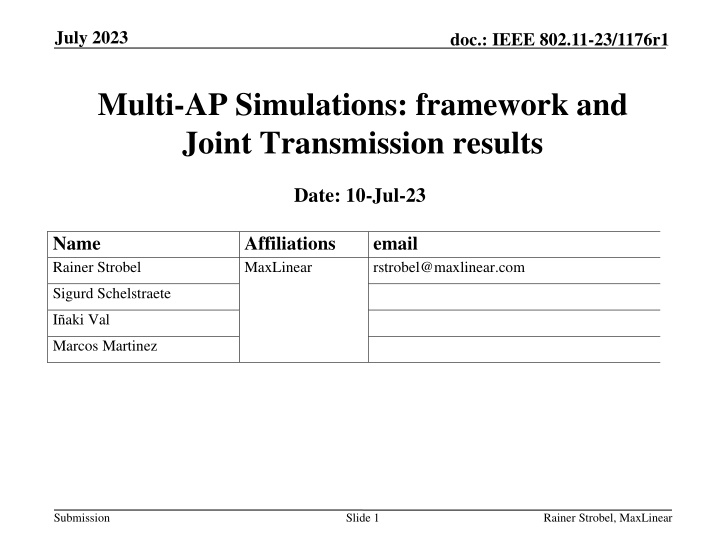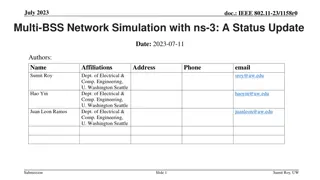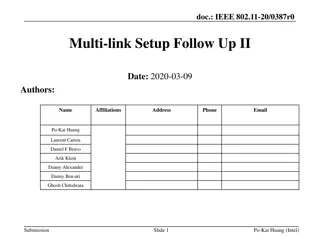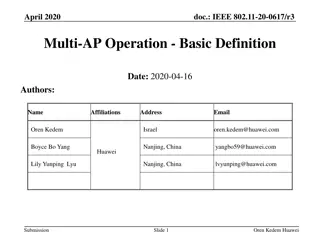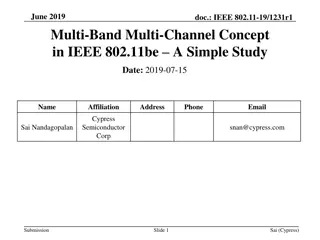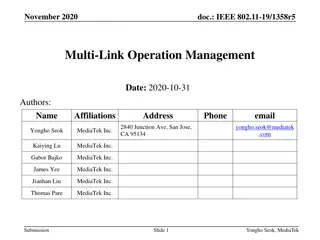IEEE 802.11-23/1176r1 Multi-AP Simulations Overview
Detailed exploration of Joint Transmission (JT) simulation results for IEEE 802.11-23/1176r1, emphasizing real-world deployment scenarios in residential settings. The submission discusses topologies, considerations, and initial simulation outcomes, aiming to align with the UHR project goals and optimize network coverage efficiently.
Download Presentation

Please find below an Image/Link to download the presentation.
The content on the website is provided AS IS for your information and personal use only. It may not be sold, licensed, or shared on other websites without obtaining consent from the author.If you encounter any issues during the download, it is possible that the publisher has removed the file from their server.
You are allowed to download the files provided on this website for personal or commercial use, subject to the condition that they are used lawfully. All files are the property of their respective owners.
The content on the website is provided AS IS for your information and personal use only. It may not be sold, licensed, or shared on other websites without obtaining consent from the author.
E N D
Presentation Transcript
July 2023 doc.: IEEE 802.11-23/1176r1 Multi-AP Simulations: framework and Joint Transmission results Date: 10-Jul-23 Name Rainer Strobel Affiliations MaxLinear email rstrobel@maxlinear.com Sigurd Schelstraete I aki Val Marcos Martinez Submission Slide 1 Rainer Strobel, MaxLinear
July 2023 doc.: IEEE 802.11-23/1176r1 Introduction Various contributions have presented Joint Transmission (JT) simulation results e.g., [1, 2], [4, 5], [6 7] Simulation methodology, simulation parameters and scenarios vary for the different submissions Details in Appendix We believe simulation scenarios should inherently reflect the realities of in-home deployment Analysis that is too abstract or statistical is of limited value Submission Slide 2 Rainer Strobel, MaxLinear
July 2023 doc.: IEEE 802.11-23/1176r1 Goal of the submission Discuss and present topologies relevant for JT Present initial simulation results using such topologies Align simulation conditions and simulation results with the UHR project goals Focusing on residential case Submission Slide 3 Rainer Strobel, MaxLinear
July 2023 doc.: IEEE 802.11-23/1176r1 Considerations for residential JT JT is most likely to be deployed inside a single residence All APs under common control Multiple backhaul options may be available APs should be strategically placed to maximize coverage Allow the network to fall back to current mesh/extender topology when JT is not used Specifically, APs in close proximity or excessive number of APs should be avoided AP configurations (e.g., #antennas) should reflect typical in-home scenarios Unlikely to have multiple high-end APs deployed Submission Slide 4 Rainer Strobel, MaxLinear
July 2023 doc.: IEEE 802.11-23/1176r1 Topology 1: Extender ( Heterogenous APs ) Typical scenario: one main AP and one (or more) extender APs APs with different configurations Main AP may be 4x4 Extender APs have lower configurations (e.g., 2x2) APs in different rooms (multiple) wall attenuation Asymmetric Rx signal strength is typical Submission Slide 5 Rainer Strobel, MaxLinear
July 2023 doc.: IEEE 802.11-23/1176r1 Topology 2: Mesh ( Homogeneous APs ) All APs have the same configuration 2x2 is commonly used APs are separated Maybe closer than in Extender scenario Asymmetric Rx signal strength is typical Number of APs may be higher than two Submission Slide 6 Rainer Strobel, MaxLinear
July 2023 doc.: IEEE 802.11-23/1176r1 Simulation setup Evaluate throughput compared to 802.11be Aligned with KPIs in UHR PAR Compare with the best legacy mode (BF, MU-MIMO) Residential scenario based on [8] Three 10m x 10m rooms, 5dB wall loss AP1 in room 1 , AP2 in room 3 4 STAs total Topologies: Extender: AP1 4x4, AP2 2x2 Mesh AP1 2x2, AP2 2x2 Impairments or backhaul overhead not considered yet Submission Slide 7 Rainer Strobel, MaxLinear
July 2023 doc.: IEEE 802.11-23/1176r1 Simulation setup (2) For each topology (Extender + Mesh), throughput will be evaluated for (1) SU (with BF), (2) MU-MIMO and (3) JT (with MU-MIMO) Evaluated for different possible locations of the STAs Pattern 1: group of 4 STAs moved from Room 1 (X=1) to Room 3 (X=29) in steps of 2m: ? ??????1 4 Pattern 2: group of 2 STAs moved from Room 1 (X=1) to Room 3 (X=29) in steps of 2m while second group moves from Room 3 to Room 1: = 1 + 2 ?, ? = 0:14 ? ??????1,3 ? = 1 + 2 ?, ? = 0:14 ??????2,4 = 29 2 ?, ? = 0:14 Submission Slide 8 Rainer Strobel, MaxLinear
July 2023 doc.: IEEE 802.11-23/1176r1 Simulation parameters Parameter Value TX/RX Antennas 4/2 APs/STAs 2/4 (2 STAs per AP) Spatial streams 1 or 2 (optimized) Bandwidth 160 MHz AP TX Power 24 dBm Channel model D NLOS [8] MCS 0-13 (optimized) Frequency 5.25GHz GI 1.6 s TX/RX SNR 41dB/43dB Channel aging/Doppler 1.2km/h, 6Hz BF quantization ideal Precoder type SVD (SU), MMSE (MU) Sounding interval 100ms (SU), 10ms (MU) Overhead Sounding and MAC overhead not considered SU time allocation 25% for each STA MU allocation 4 STAs served by one AP Submission Slide 9 Rainer Strobel, MaxLinear
July 2023 doc.: IEEE 802.11-23/1176r1 Heterogenous Topology legacy Beamforming SU with BF Best AP selected 4 STAS served simultaneously, TDMA between STAs, 25% transmit time per STA Identical for both movement patterns Submission Slide 10 Rainer Strobel, MaxLinear
July 2023 doc.: IEEE 802.11-23/1176r1 Heterogenous Topology legacy MU MIMO Movement pattern 1 (4 STAs moving in same direction) Movement pattern 2 (2 groups of 2 STAs moving in opposite directions) Submission Slide 11 Rainer Strobel, MaxLinear
July 2023 doc.: IEEE 802.11-23/1176r1 Heterogenous Topology Joint Transmission Movement pattern 1 (4 STAs moving in same direction) Movement pattern 2 (2 groups of 2 STAs moving in opposite directions) Submission Slide 12 Rainer Strobel, MaxLinear
July 2023 doc.: IEEE 802.11-23/1176r1 Extender Topology: Comparison BF, MU-MIMO, JT Rate per STA vs. x axis position Submission Slide 13 Rainer Strobel, MaxLinear
July 2023 doc.: IEEE 802.11-23/1176r1 Homogenous Topology legacy Beamforming SU with BF Best AP selected 4 STAS served simultaneously, TDMA between STAs, 25% transmit time per STA Submission Slide 14 Rainer Strobel, MaxLinear
July 2023 doc.: IEEE 802.11-23/1176r1 Mesh Topology legacy MU MIMO Movement pattern 1 (4 STAs moving in same direction) Movement pattern 2 (2 groups of 2 STAs moving in opposite directions) Submission Slide 15 Rainer Strobel, MaxLinear
July 2023 doc.: IEEE 802.11-23/1176r1 Mesh Topology Joint Transmission Movement pattern 1 (4 STAs moving in same direction) Movement pattern 2 (2 groups of 2 STAs moving in opposite directions) Submission Slide 16 Rainer Strobel, MaxLinear
July 2023 doc.: IEEE 802.11-23/1176r1 Mesh Topology: Comparison BF, MU-MIMO, JT Rate per STA vs. x axis position Submission Slide 17 Rainer Strobel, MaxLinear
July 2023 doc.: IEEE 802.11-23/1176r1 Conclusions We evaluated performance of JT vs. different legacy transmission schemes (BF, MU-MIMO) We believe correctly capturing the characteristics of in- home topologies is important to understand the value of this technology JT can provide benefits, but strongly dependent on STA locations and network topology Complexity and impact from backhaul need to be considered still Submission Slide 18 Rainer Strobel, MaxLinear
July 2023 doc.: IEEE 802.11-23/1176r1 References [1] Spatial Reuse in Coordinated M-AP for UHR , IEEE 802.11-23/0058r0 [2] On Joint C-SR and C-OFDMA M-AP Transmission , IEEE 802.11- 20/1399r2 [3] Simulation Scenarios IEEE 802.11-14/0980r16 [4] Joint Transmission for UHR Additional Results , IEEE 802.11-23/0243r0 [5] Joint Transmission for UHR A Refresher and New Results , IEEE 802.11- 22/2188r0 [6] System Level Simulation of Co-BF and Joint Tx , IEEE 802.11-22/1821r0 [7] Recap on Coordinated Spatial Reuse Operation , IEEE 802.11-22/1822r0 [8] TGax Simulation Scenarios , IEEE 802.11-14/0621r3, Simone Merlin, etc. [9] Consideration of Industrial Automation Scenarios , IEEE 802.11-23/0815r0, 2023-05 [10] Kosuke Aio (Sony Corporation), Consideration on Multi-AP Home Mesh Scenario, 20/0032r0, January 2020. [11] Dmitry Akhmetov (Intel) et. al. Multi-AP coordination for spatial reuse , IEEE802.11-20/0107r1 Slide 19 Submission Rainer Strobel, MaxLinear
July 2023 doc.: IEEE 802.11-23/1176r1 APPENDIX Submission Slide 20 Rainer Strobel, MaxLinear
July 2023 doc.: IEEE 802.11-23/1176r1 Example Movement Patterns STAs move in the same direction All STAs in the same room (worst case for joint transmission) STAs move in opposite directions Large SNR difference between STAs (worst case for MU MIMO) Submission Slide 21 Rainer Strobel, MaxLinear
July 2023 doc.: IEEE 802.11-23/1176r1 Simulation Scenarios [1, 2] is based on 11ax [8] enterprise scenario [6, 7] uses [10], based on 11ax [8] residential scenario [4, 5] uses a generic SNR model, based on channel SNR and the attenuation between the AP-STA links Conclusion: 11ax [8] residential and enterprise scenario are a good baseline Is the channel attenuation assumption valid? Are the residential room sizes reasonable (e.g., [11] uses different parameters) A simplified model (as in [4, 5]) may be derived from that The 11ax scenarios can be extend (e.g., as proposed in [9]) for other use cases Submission Slide 22 Rainer Strobel, MaxLinear
July 2023 doc.: IEEE 802.11-23/1176r1 Parameter Table (from references [2, 5, 7]) Parameter Value Parameter Value TX/RX Antennas 4/2 [5] 4/1 [7] Phase offset 0-180 [5] APs/STAs 2-3/4-6 [5], 2-3/2-3 [7], 4/8 [2] TX SNR 38dB [5] Spatial streams Opt. [5], 1 [7] Channel aging -30dBc [5] Bandwidth 80MHz [2, 5, 7] Doppler 0Hz [7] Channel model [5]11nD [7] D NLOS as in [10] [2] from [8] BF quantization 9/7 [6, 7] MCS 0-11 [7], 0-9 [2] Precoder type ZF [5], SVD-MMSE [7] AP/STA TX power/dBm 21/15 [7] 20/x [2] Sounding interval 100ms [7] Frequency 5.18GHz [7] Noise figure 7dB [2] GI 0.8 s [7] Submission Slide 23 Rainer Strobel, MaxLinear
July 2023 doc.: IEEE 802.11-23/1176r1 Simulation Result Presentation Throughput CDF used in [1, 2, 3, 6, 7] System level simulations Gain vs. channel SNR used in [4, 5] 2-dimensional data (channel SNR and attenuation between channels) Conclusion: The UHR goal of Rate-vs.-range improvement fits best to a result presentation of data rate coverage in the served area Or an equivalent mapping to channel SNR Submission Slide 24 Rainer Strobel, MaxLinear
